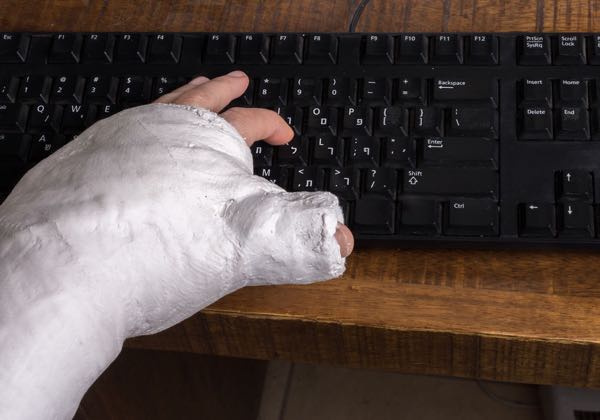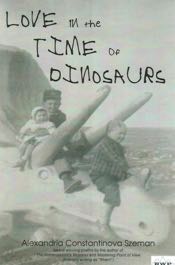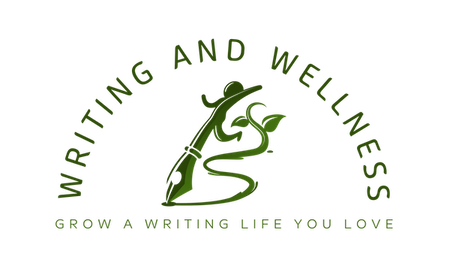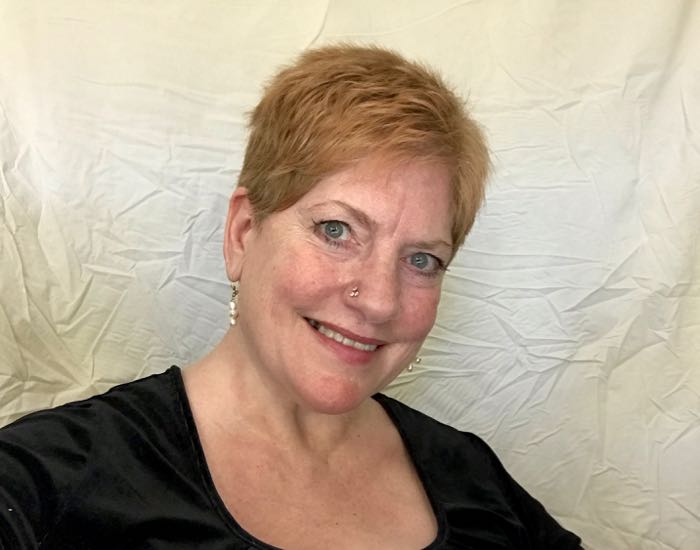When I was younger, the biggest physical challenge of being a writer was overuse injuries to my hands and wrists.
Because I often worked several jobs to support myself—teaching jobs, which virtually always included writing out lesson plans and grading papers—and because I wrote my poetry and fiction before going to work every day at my paying jobs, I suffered swelling of my wrists, hands, and fingers. I write longhand, and I remember times when the pain of writer’s cramp was excruciating.
 Writers at Risk for De Quervain’s Syndrome
Writers at Risk for De Quervain’s Syndrome
The worst physical injury from writing was De Quervain’s Syndrome—an overuse injury from too much typing.
I’d borrowed $11K from the bank (at 17 7/8% interest, for a total loan repayment of $18K) to take nine months off work, without pay, and write my first novel. I lived on the loan during that time off from work (while making monthly payments on the loan). My time was limited, so I was soon working 8, 10, 12, then 14 hours a day on the novel, in an attempt to get a first draft done before I had to return to work.
I had a computer by then, and I have to say, it was easier to spend 10-14 hours a day typing on a computer than it had ever been working on a typewriter. That and the time-constraints contributed to my overworking. The tissue in my hands, wrists, and forearms swelled to the point where the nerves passing through the tunnels in the wrists were pressed against the bones, causing numbness, pain, and an inability to keep my grip on things, especially delicate things like my fountain pen.
When I began dropping cups of coffee and was unable to hold my pen to write, I was convinced I had a serious and most likely terminal illness: determined to finish my novel before I died, I worked longer and harder.
One day, every keystroke sent searing nerve-pain through my hands, wrists, and forearms: I thought my computer was shorting-out and called for a repair. It wasn’t the computer. After a weekend of being unable to bend my fingers or use my hands and wrists without debilitating pain, I went to my doctor. She knew I was writing full-time for nine months, so she immediately checked for overuse injuries like carpal tunnel syndrome and De Quervain’s Syndrome.
When I yelped in pain during the test for De Quervain’s, she said, “You’re typing a lot, right? Too much, I’m guessing. Maybe two-to-four hours a day?”
The horrified look on her face when I admitted to 8-10 hours of typing a day was quickly replaced by a lecture and stern warnings that I could permanently lose the use of my hands and fingers if the nerves in my wrists were severed. She told me I was asking my fingers, hands, and wrists to do the equivalent of running a marathon every single day.
She sent me to the hospital where physical therapists casted my hands, wrists, forearms, and thumbs. It seems that the best way to immobilize your wrists is to prevent your thumbs from moving or being used. The half-hour I spent in the hospital parking lot trying to pick up my dropped keys after having both hands and arms casted convinced me that humans owe much of their evolution to opposable thumbs.

Writers Must Take Regular Breaks!
I was in those casts for four months. And it still didn’t stop me from typing.
I erroneously believed that as long as my wrists were immobilized by the casts, I could use my fingers, so I did. I may have gotten a little bit of work on my novel done, but because I continued over-using my fingers, it took almost a year to completely recover.
After the initial four months in casts, they put my hands and wrists into splints with metal bars that kept the thumbs immobilized. Eventually, I learned not to abuse my body like that again: I take a break from writing and typing every 10-15 minutes (doctor’s orders), and have done hand and wrist exercises since my recovery from the initial injury.
I can only assume that taking regular breaks from writing and typing, along with the physical therapy to strengthen my hands and fingers, has helped reduce my hand/wrist injuries from being a writer.
 How Yoga and Tai Chi Can Help Writers Avoid Hip and Back Pain
How Yoga and Tai Chi Can Help Writers Avoid Hip and Back Pain
The biggest physical challenge I face now as a writer is hip and lower back pain.
When I was three, I was raped and severely injured by my father: he broke several bones, including my right collarbone and shoulder, and dislocated my right hip. I didn’t know about the hip-dislocation till I was in my mid-40s and going to medical massage therapists.
They eventually got my hip back into place, but if I sit too long, the hip dislocates. The psoas (SO-as) muscle, which is shortened when sitting, gets progressively tighter and pulls the muscles around the hip and lower back, pulling my hip out of place—which is unbearably painful in itself—then triggering the muscles in my lower back, nearest the damaged hip, making it almost impossible to get up from my desk and stand straight.
Since I have to take breaks from writing and typing every 10-15 minutes for my fingers, hands, and wrists anyway, I use those breaks to stretch my hips and back. I do yoga and T’ai Chi stretches aimed at the psoas muscle, the hips, hamstrings, and lower back. I walk every day on the treadmill, which is in my office, and I regularly see my medical massage therapist to deal with the dislocated hip and lower back pain.
 Writing a Memoir Can Be a Painful Experience
Writing a Memoir Can Be a Painful Experience
The biggest emotional challenge in my writing career has always been dealing with my childhood sexual abuse and rapes (by my father, stepfather, and mother [with implements]), and with the Munchausen’s by Proxy (MBP) abuse inflicted by my mother.
I dealt with the rapes and sexual slavery in my first novel, The Kommandant’s Mistress, where they were vitally important to the story. I somehow thought writing such things as fiction involving a character who was clearly not me would protect me from emotional pain.
It didn’t.
In fact, it was some of the most difficult and painful writing I’ve ever done. Though none of the rapes in the novel is graphic, writing them caused all my own physical, psychological, and emotional pain to resurface. I still remember doing the first rape scene in the novel: it took weeks of grieving for me to write that scene; when I typed it, the grieving returned, just as fiercely, perhaps because typing it made it more real or, at the very least, more public.
My true crime memoir, M is for Munchers: The Serial Killers Next Door, was even more difficult writing since it encompassed not only the childhood rapes and incestuous sexual abuse, but also the more life-threatening and permanently damaging Munchausen’s by Proxy (MBP) abuse.
Women who practice MBP have a severe and incurable personality disorder. When they are younger, or when they have no other potential victims, they injure themselves or induce their own illnesses in order to get attention and sympathy from medical personnel and family members.
Once they have children or are taking care of someone else dependent on them, like elderly parents or a terminally ill spouse, these women transfer their harmful and abusive behavior to their children or others in their care. The MBP-women intentionally harm, injure, or induce illness in others to get attention for themselves for being such a loving mother or caregiver.
Writing the memoir caused me at least as much emotional pain as writing the rape and sexual abuse scenes for my first novel had, if only because I was not hiding behind the mask of fiction but openly writing about my own life and family. I had to publicly come to terms with the fact that everyone in my entire extended family knew about the rapes, the sexual abuse, and the MBP abuse inflicted on me but had done nothing to help or protect me.
 How Fellow Survivors on Social Media Helped Me Feel Less Isolated
How Fellow Survivors on Social Media Helped Me Feel Less Isolated
The publication of my memoir triggered many panic attacks, no doubt from fear of not being heard or believed since my family, though they always knew I was telling the truth about the abuse, constantly punished me whenever I told someone what was happening. I was instructed to “stop airing the family’s dirty laundry in public.”
When I was young, I thought family members were calling me a “liar,” but when I confronted my grandmother about it once, she indignantly insisted that she had never used the word “liar” but had simply wanted me to stop telling people about the abuse so that my mother, father, and stepfather would not be prosecuted and locked up.
Surprisingly, one of the most healing influences of the emotional trauma of writing—besides putting my own abuse into books and being in therapy for almost 20 years—has been social media, which I joined in 2010. With survivor-advocates like Rachel Thompson leading the way, I’ve become more comfortable sharing my own story of severe abuse and have become a survivor rather than a victim.
I’ve even written several blog posts about the abuse I suffered. Having an empathetic group of fellow survivors connecting with me on social media, as well as through my blog posts and books, has helped me feel less isolated.
Why I Can Manage the Challenges of Writing and Publishing
In the last three years, I’ve added meditation, yoga, and T’ai Chi to my daily walking, since those things help greatly with the emotional demands I encounter when I write.
No matter how painful the rejection of writing life, no matter how disappointing it is to have a book taken out of print, or to have an optioned book not made into a film as planned, the pain of those events is nothing compared to the pain of my severely abusive childhood.
No matter how crushing anything in my career as writer and author has seemed, I know that I’ve survived much worse—and in my childhood, no less—so I know I can survive any of the more challenging aspects of being a writer and a published author.
 How E-Books and Print-On-Demand Have Saved Authors from the Dark Side of Traditional Publishing
How E-Books and Print-On-Demand Have Saved Authors from the Dark Side of Traditional Publishing
Thanks to the invention of e-books, portable e-readers, and print-on-demand (POD) technology, as well as the advent of the Indie publishing movement, most writers and authors will never have to deal with the darkest moments of traditional publishing: (1) rejection by agents, editors, and publishers, and (2) having a book taken out of print (OP).
Moreover, being rejected, no matter how much it might hurt an author’s ego, is nothing compared to the agony of having a book published but then taken out of print.
Previously, when traditionally published books were taken out of print, for any reason at all, such as the editor’s going to a different House, the book was “dead.” Before reliable e-readers were invented, self-publishing was not an option for authors: Amazon didn’t exist, and brick & mortar bookstores wouldn’t carry self-published titles.
Even now most corporate bookstores don’t stock any books except those published by traditional Houses. Authors with OP books couldn’t get them back into print unless an agent negotiated a new publishing contract with a different House, and authors couldn’t get the books back into bookstores unless a traditional publisher re-issued the book.
What a nightmare, controlled entirely by traditional publishers and corporate bookstores.
Though my own agents tried many times to get my OP titles back into print, most publishers were not interested. They assumed, erroneously, that any OP title had failed to earn out its advance, i.e., the publisher had not recouped advance monies from book sales. Publishers don’t usually care about the critical reception a book has had, only the sales figures.
In fact, despite earning out my advances and despite my winning numerous awards and receiving good critical reviews, the only reason The Kommandant’s Mistress got put back into print after HarperCollins took it OP was because Patrick Stewart had optioned it for film and because my agent and I literally gave the publishing rights free of charge—for as long as the book remained in print—to the publisher of my second novel, simply to have the first novel back in print and available to bookstores.
The print-on-demand (POD) and e-book revolution not only eliminated the OP-hell where traditionally published authors were often permanently trapped, but it gave all writers and authors more options to publish and market their works, and to make their books more accessible to readers.
One of the first things I did after e-books were reliably available was put all my OP titles back out into the market. My last traditional publishing contract was issued in 2007, and it made no mention whatsoever of “electronic books,” which shows you just how much the publishing industry changed from 2008-2012, when I put multiple OP titles out as e-books.
 Advice for a Young Writer: Don’t Do It Unless You Can’t Live Without It
Advice for a Young Writer: Don’t Do It Unless You Can’t Live Without It
The only thing you need to do to be a writer is write—diary, journal, stories, poems, articles, blog posts—preferably every day. An author is a published writer, which means you’ve sent your work out into the world, and that means rejection, whether your work is rejected by agents, editors, critics, or readers. Rejection is part of the business, so writers who want to be authors should get used to it.
After publication, the business of being an author includes writing, more rejection, and marketing. Famous authors are usually wealthy enough to hire their own lawyers or managers, but most of them still have to go to bookstores to do readings or signings when they have a new book out. Many of them still teach, even if it is only occasionally at writers’ conferences, and many of them get paid to give talks at writing conferences.
It is highly unlikely that most of us will ever become bestsellers, or even be able to support ourselves and our families solely through writing income. Further, many writers who are bestsellers, like Stephen King, Anne Rice, and J.K. Rowling, lament the fact that they are not critically acclaimed or respected. (Some of them even write different-genre books under pseudonyms in an attempt to get critical recognition.)
Conversely, award-winning authors often want to become bestsellers for just one book so they can quit their day-jobs. I’ve yet to meet an established author in either group who didn’t desire what the other group had.
Writing is not glamorous: it’s hard work, the hardest work you’ll ever do. Writing is emotionally, intellectually, and physically challenging. Being an author is even harder than being a writer. My best advice for writers who want to become authors is this: Don’t do it unless you can’t live without it.
* * *
 Alexandria Constantinova Szeman, Ph.D. is author of the New York Times Book Review’s Notable Book and University of Rochester’s Kafka Award winner for “the outstanding book of prose fiction by an American woman,” The Kommandant’s Mistress, one of NYTBR’s “Top 100 Books of the Year.” She’s also the winner of the Elliston Poetry Prize for Love in the Time of Dinosaurs and Where Lightning Strikes: Poems on The Holocaust; grand prize winner in the UKA Press International Writing Competition for short story collection Naked, with Glasses; and finalist in Santa Fe Writer’s Project Literary Awards 2017 for true crime memoir M is for Munchers: The Serial Killers Next Door.
Alexandria Constantinova Szeman, Ph.D. is author of the New York Times Book Review’s Notable Book and University of Rochester’s Kafka Award winner for “the outstanding book of prose fiction by an American woman,” The Kommandant’s Mistress, one of NYTBR’s “Top 100 Books of the Year.” She’s also the winner of the Elliston Poetry Prize for Love in the Time of Dinosaurs and Where Lightning Strikes: Poems on The Holocaust; grand prize winner in the UKA Press International Writing Competition for short story collection Naked, with Glasses; and finalist in Santa Fe Writer’s Project Literary Awards 2017 for true crime memoir M is for Munchers: The Serial Killers Next Door.
For more information about Alexandria and her work, please see her website and Amazon author page, or connect with her on Twitter and Facebook.
 The Kommandant’s Mistress (novel): The rumors spread by the Camp’s inmates, other Nazi officers, and the Kommandant’s own family insist that she was his “mistress”, but was she, voluntarily? Told from three different perspectives – that of the formerly idealistic Kommandant, the young Jewish inmate who captivates him, and the ostensibly objective historical biographies of the protagonists – this novel examines one troubling moral question over and over: if your staying alive was the only “good” during the War, if your survival was your sole purpose in this horrific world of the Concentration Camps – whether you were Nazi or Jewish – what, exactly, would you do to survive? Would you lie, cheat, steal, kill, submit?
The Kommandant’s Mistress (novel): The rumors spread by the Camp’s inmates, other Nazi officers, and the Kommandant’s own family insist that she was his “mistress”, but was she, voluntarily? Told from three different perspectives – that of the formerly idealistic Kommandant, the young Jewish inmate who captivates him, and the ostensibly objective historical biographies of the protagonists – this novel examines one troubling moral question over and over: if your staying alive was the only “good” during the War, if your survival was your sole purpose in this horrific world of the Concentration Camps – whether you were Nazi or Jewish – what, exactly, would you do to survive? Would you lie, cheat, steal, kill, submit?
Flashing back and forth through the narrators’ memories as they recall their time before, during, and after the War, and leading, inevitably, to their ultimate, shocking confrontation, “Szeman’s uncompromising realism and superb use of stream-of-consciousness technique make [this novel] a chilling study of evil, erotic obsession, and the will to survive” (Publishers Weekly).
Chosen as one of the New York Times Book Review‘s Notable Books and “Top 100 Books of the Year,” and Winner of the University of Rochester’s Kafka Prize for “the outstanding book of prose fiction by an American woman” and the tales told by the Kommandant, his “mistress”, and their “biographer” will mesmerize and stun you, leaving you wondering, at the conclusion, which, if any, is telling the complete truth about what happened between them.
Available at Amazon and Barnes & Noble.
 M is for Munchers: The Serial Killers Next Door (true crime memoir): “The first time somebody tried to kill me, I was four years old.” Thus begins the true crime memoir of a woman who survived a serial killer.
M is for Munchers: The Serial Killers Next Door (true crime memoir): “The first time somebody tried to kill me, I was four years old.” Thus begins the true crime memoir of a woman who survived a serial killer.
Serial killing has been discovered in many cultures around the world. Humans are capable of such dreadful crimes, and also of committing them repeatedly. Most scholars, psychologists, and law enforcement officers concentrate on researching male serial killers—especially the ones they term “sexual predators,” like Ted Bundy, John Wayne Gacy, and Jeffrey Dahmer. It’s been discovered, however, that female serial killers are infinitely more successful and dangerous than their male counterparts.
Black Widow serial killers usually murder husbands, lovers, boyfriends, children, and even boarders for insurance proceeds, inheritance money, or Social Security checks. The most dangerous category of female serial killers are the women who viciously abuse, torture, and often kill their own children, children in their care, or others who are entirely dependent upon them.
Posing as ideal mothers and self-less caregivers, these female serial killers practice Munchausen’s by Proxy (MBP), an incurable personality disorder where the woman intentionally and repeatedly sickens, injures, tortures, abuses, and kills her victims in order to get attention, respect, admiration, and love for herself.
Often called “Munchers” by those in law enforcement and the medical establishment who eventually discover the terrible truth behind the illnesses, injuries, and deaths of the children and others in their care, women who practice Munchausen’s by Proxy are the most dangerous of all serial killers because they operate openly, virtually flaunting their crimes while appearing, at the same time, to be completely and unquestionably innocent. They are the serial killers next door.
Available at Amazon.
 Naked, with Glasses (short stories): The same dark humor, morally ambiguous subject matter, and sophisticated treatment found in Szeman’s novels and poetry collections are present in her stories.
Naked, with Glasses (short stories): The same dark humor, morally ambiguous subject matter, and sophisticated treatment found in Szeman’s novels and poetry collections are present in her stories.
Quirky characters abound. “BusMan,” in the story of the same name, re-invents himself as a superhero after an unexpectedly frightening incident on his daily route. Vincent, “Hunchback of the Midwest” and member of a traveling freak-show, regales his audience with tales of conquests over beautiful women, all the while longing for the one beauty he fears he will never possess.
Thirty years after the end of the violently protested 1960-70’s “conflict,” the Vietnam War comes to a small town’s Convenience Store in the surprisingly affecting and disturbing “VC in the USA.” As in Szeman’s other work, the universal themes of family, love, loss, loyalty, and betrayal are visited in this collection as well.
Available at Amazon and Barnes & Noble.
 Love in the Time of Dinosaurs (poetry): Includes all Szeman’s non-Holocaust poetry from 1980-2010. Many of the poems begin with a narrator’s or character’s questioning his expectations of life versus the reality s/he encounters. Imaginative depictions of mythological, literary, and biblical characters’ lives frequently appear: from Cain to Ahab’s Wife, from Penelope to Ulysses. Characters from Szeman’s award-winning short story collection are present, including favorites like Eddie Madison and his friend Auggie Vernon, as each explores the suddenly unfamiliar landscape of his marriage and fatherhood, or attempts, through dubious methods, to discover God Himself.
Love in the Time of Dinosaurs (poetry): Includes all Szeman’s non-Holocaust poetry from 1980-2010. Many of the poems begin with a narrator’s or character’s questioning his expectations of life versus the reality s/he encounters. Imaginative depictions of mythological, literary, and biblical characters’ lives frequently appear: from Cain to Ahab’s Wife, from Penelope to Ulysses. Characters from Szeman’s award-winning short story collection are present, including favorites like Eddie Madison and his friend Auggie Vernon, as each explores the suddenly unfamiliar landscape of his marriage and fatherhood, or attempts, through dubious methods, to discover God Himself.
As powerfully written, darkly humorous, surprising, and accessible as her prose works, these poems let you glimpse into the hearts, lives, and minds of ordinary people — whether they be mythological, biblical, literary, or contemporary — as they struggle to make sense of relationships, family, marriage, divorce, children, spirituality, faith, and the existence of God. As they struggle to comprehend the very things each of us experiences every day.
Available at Amazon and Barnes & Noble.


No child should ever have to suffer this kind of extreme cruelty. Thank you for telling your story, Alexandria.